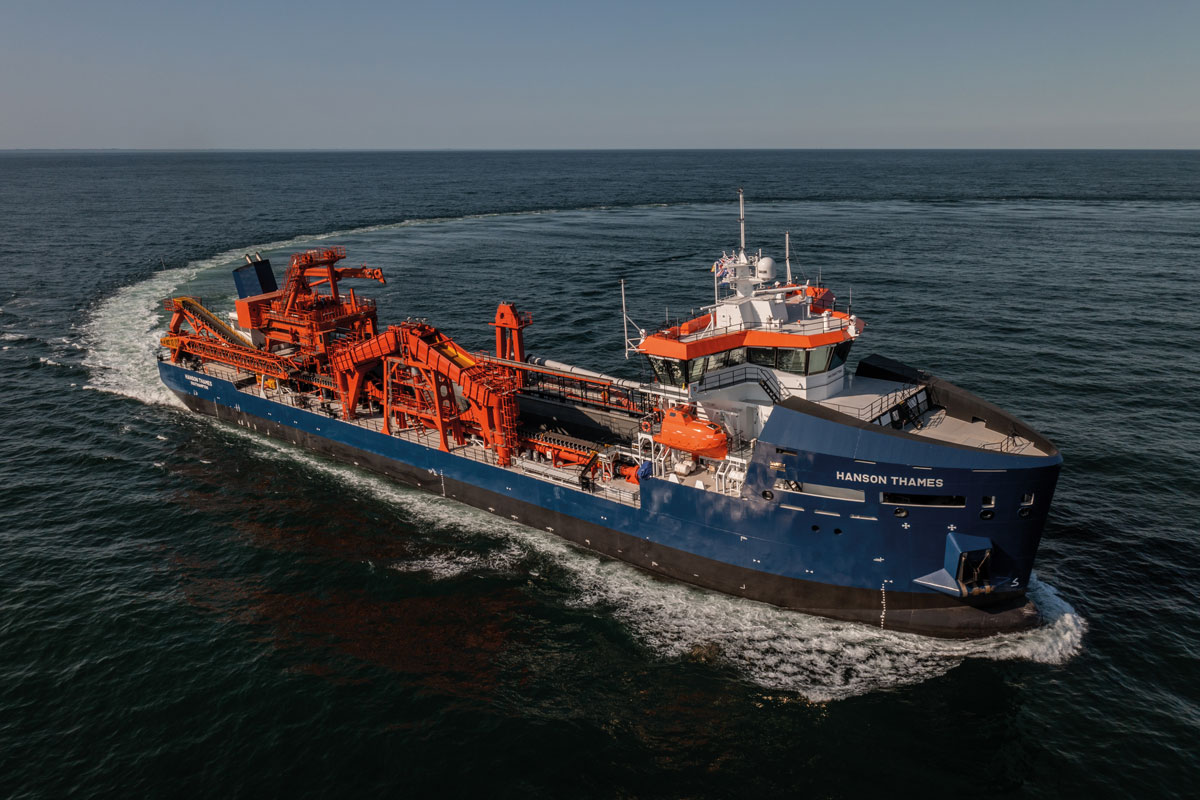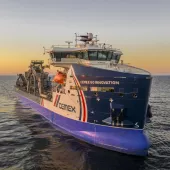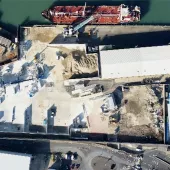Dredging Responsibly

First published in the March 2022 issue of Quarry Management
Marine dredging plays an important part in the supply of sand and gravel to the construction sector and its role is set to grow as land-based supply is limited. Hanson Aggregates Marine, part of Hanson UK, are one of the key players in the UK and continental market, supplying around 5 million tonnes of material each year. They own a purpose-built fleet of four marine aggregate dredgers (MADs), including their new vessel, Hanson Thames, which began operating earlier this year. Hanson’s marine resources manager, Dr Nigel Griffiths, reveals some current themes and unusual finds made through the company’s operations
In areas around London and the South East, land-based reserves are scarce and marine-dredged sand and gravel play an important role. Hanson’s marine aggregates are supplied to the UK, France, The Netherlands, and Belgium and are primarily used in ready-mixed concrete for projects such as Thames Tideway, Crossrail, and in prestigious high-rise buildings, but also in the production of concrete blocks and as bagged aggregates.
The company supplies direct to wharves using its own fleet and supports beach replacement to combat coastal erosion using specialist third-party vessels that can pump or spray ashore. It has licences to operate areas in the Humber, Anglian and Thames regions, South Coast, Eastern English Channel, and the Bristol Channel/Severn Estuary.
Licensing and laws
The use of marine aggregates reduces the need for quarrying on land as well as associated transport emissions, but dredging the seabed brings with it a responsibility to protect the marine environment and operators must work within strict controls. Unlike aggregate resources on land, which are mainly in private ownership, nearly all offshore minerals are owned by the Crown Estate and their exploitation is subject to strict controls.
All the areas where Hanson extract marine aggregates are held under both commercial and legal production agreements issued by the Crown Estate and environmental-based marine licences issued by either the Marine Management Organisation (English waters) or Natural Resources Wales (Welsh waters).
These licences are only issued by the regulator after a rigorous environmental impact assessment to ensure that all the potential effects on the environment of offshore dredging (including effects on the coastline, marine life, fisheries, and archaeology) are fully considered and, where required, appropriate mitigation is in place. This is to ensure that best practice is always followed and that activities do not have any adverse effects on the marine environment.
Hanson work closely with Natural England, The Joint Nature Conservation Committee, Historic England, and many other authorities to minimize the impact of dredging on species and habitats and any potential impact on the coast. The company collaborates with other operators to survey and collect data to assess local and regional impacts and develop biodiversity action plans. These help to ensure that the seabed is left in a condition which will encourage the re-establishment of a diverse marine environment.
It is important to consider the historic marine environment too, and protocols are in place between industry and Historic England for reporting and investigating archaeological finds on the ships and at the wharves. Finds can include prehistoric or fossilized remains such as mammoth bones, teeth, and tusks from the ice ages, to more modern cannon balls and occasional aircraft wreckage from WWII.
Hanson have a marine resources team which is responsible for the extensive permitting and licensing activities necessary to maintain access to these high-quality reserves. This includes ensuring that the navigational and licence information systems are up to date and communicated to the fleet and highlight those areas where dredging may and may not take place. Exclusion zones can be included based on seasonal requirements for fisheries, or on the discovery of a wreck or other features of archaeological importance.
Extraction
Marine sand and gravel resources vary in thickness and quality, as well in as their proximity to markets. Unlike land-based quarry sites, production from marine resources does not always take place in the same deposit and is driven by customer demand.
All marine aggregate extraction is undertaken to a high degree of accuracy, with reference to high-resolution shallow seismic profile data and seabed core samples. When loading a cargo, the dredger’s position and tracks are displayed on the bridge in real time, together with geological and licence boundaries, to ensure that high-quality resources are extracted from the correct location. The vessel’s activity is also constantly recorded by a Crown Estate electronic monitoring system linked to the navigation receiver and the dredge equipment sensors. This records when and where the ship is dredging to ensure the vessels are working in agreed discreet and monitored areas within the licence conditions.
Screening for quality takes place on board the dredgers to limit the amount discarded following dredging and ensure deposit recovery is optimized.
Uncovering the past
Responsible dredging, like quarrying, helps uncover the past by revealing prehistoric remains that provide archaeologists with new perspectives and extend their knowledge of the past, with the marine environment often preserving buried landscapes and artefacts.
Hanson play an important role in analysing, protecting, and preserving the UK’s national heritage and have close working relationships with specialist companies, including Wessex Archaeology, who regularly monitor cargo at the company’s sites and gives advice to its ships’ crews when finds are made.
A good example is Area 240, which is around 12 miles off the coast of Great Yarmouth in East Anglia and is of particular importance internationally. Since 2011, a large number of finds – such as hand axes, flints, and mammoth bones – have been uncovered, which indicate early man was living and hunting there around 300,000 years ago. At that time, the area was dry land with rivers but now it is 25m below sea level. Members of the Hanson team at Dagenham help arrange regular inspections of the cargo by Wessex Archaeology and get actively involved, often making important finds.
Sampling at Dagenham is hugely important in the evolving Area 240 story. Hanson are obliged by their licence conditions to regularly monitor their cargo, but the professional attitude and personal interest of the Dagenham team has led to them making some significant finds that help add to the knowledge of this internationally important site. For example, the company is currently awaiting confirmation from experts at the Natural History Museum that a bone found by an employee shows markings of being butchered by a hand-axe.
Investment
Hanson Thames is the company’s new MAD 3500 vessel. It has completed its sea trials and safety certifications and now operates in the North Sea and English Channel. Built by Damen Shipyards Group at their Galati yard in Romania, the vessel is capable of extracting marine-dredged aggregates in water up to 55m deep and has been designed to ensure safe, comfortable operations – even in adverse conditions.
The vessel’s innovative design provides increased payload and efficiency, which will allow it to carry up to 7,000 tonnes of marine aggregates per trip, as well as reducing fuel consumption (and associated CO2 emissions) by up to 11% and improving operational and maintenance savings. Other benefits include reduced maintenance and increased uptime, a modular design that allows easy replacement of worn parts, exceptional stability offering crew comfort and the capability to work in rough seas, and fast and efficient dry-side unloading.
The introduction of Hanson Thames forms part of Hanson’s strategy to replace their existing ageing dredgers, which supply essential sand and gravel to projects in the UK as well as to their sister companies in the near continent. Marine aggregates are becoming increasingly important due to the increasing scarcity of land-won reserves and, in markets such as London and the Bristol Channel, represent up to 90% of the total sand and gravel supplied and used in the area.
- Subscribe to Quarry Management, the monthly journal for the mineral products industry, to read articles before they appear on Agg-Net.com






